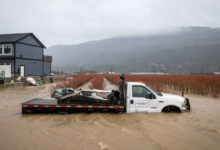Toronto launches $3B project to improve water quality in Lake Ontario and city’s waterways
City officials have launched Toronto’s largest and most significant storm water management program — the Don River and Central Waterfront and Connected Project — which will halt the flow of sewage into Lake Ontario and clean up waterways.
The first phase of the five-phase project — the Coxwell Bypass Tunnel — will see a 10.5 kilometre long and 6.3 metre wide tunnel built at a cost of $400 million. The overall project is expected to cost $3 billion.
“Currently, when a major storm hits our city… and dumps huge quantities of rain water onto the city… the wastewater system goes into overdrive to prevent major flooding,” Mayor John Tory said Saturday.
As the water rushes in, Tory said, the system pushes wastewater overflows into the rivers and into Lake Ontario when it reaches a certain threshold.
Tory said the city was faced with the “difficult and unacceptable choice” of excess wastewater rushing back up through the sewer system and into people’s basements, or allowing it to go into in Lake Ontario.
“Both of those alternatives are obviously unacceptable, but the choice was made to have the tainted water go into the lake,” he said.
“I could not and do not accept continuing on with this being the only way in which we can handle wastewater, which is why I committed to a new dramatically accelerated plan to stop the practise of having this tainted water go into the lake.”
Back in 1987, the International Joint Commission, guided by the Boundaries Waters Treaty, identified Toronto’s waterfront as one of the 43 polluted areas of concern in the Great Lakes basin, with the Don River and inner harbour being particularly polluted by combined sewer outflows.
Plans put in place by previous administrations over the years said that by 2038, waste water dumped into the lake would finally be as close to zero.
“I just felt that was far too long,” Tory said, adding his goal is to make that a reality in about half the time — within 10 years.
The complete Don River and Central Waterfront Tunnel System will include a 22-kilometre tunnel system consisting of three integrated tunnels, 12 wet weather flow storage shafts along the tunnels, 12 connection points to the tunnels for storm water and combined sewer overflows, seven offline storage tanks and the technology necessary to regulate the flows inside the city’s sewer system.
“Once this work is complete, it will capture and store combined water-sewer outflows during significant rainfall,” Tory said.
Once all five projects are completed, the combined sewer overflows will be pumped to the Ashbridges Bay Wastewater Treatment Plant for ultraviolet disinfection.
During excessive flows caused by heavy rain, it will be treated at a new high-rate treatment facility that will be built at Ashbridges Bay.
Toronto cannot do it alone, says mayor
Tory said Toronto cannot bear the cost of the project alone, but the city could not wait for help before it begins to address the problem.
He said he has held discussions with both of the other levels of government to partner with Toronto in getting the work done.
“While we’re continuing to urge the federal and provincial governments to partner with is in this crucial environmental initiative, we’re not waiting to get going,” Tory said.
“It is a core responsibility that we have for our generation … but also for the next generation to stop dumping raw sewage into Lake Ontario and into the waterways that flow into it. We now know that in a post climate change world, these storms unfortunately are a part of life that is going to happen for some time to come and we just can’t allow the status quo to prevail,” Tory added.
Through the project, the city says it will accomplish the following:
- Improvements to the aquatic habitat for fish and other wildlife.
- Support for the revitalization efforts along the central waterfront.
- Greater opportunities for residents and visitors to enjoy water activities.
- Improvement to the overall water quality of one of the world’s largest fresh water lakes.
Coun. Jennifer McKelvie (Ward 25, Scarborough-Rouge Park), who also spoke at Saturday’s launch, said the project is an important one that will make the city more resilient to the impacts of climate change
McKelvie, the vice chair of the infrastructure and environment committee, said the Coxwell Bypass Tunnel will be dug by a 115-metre machine, which weighs close to 1,000 tonnes.
The tunnel will run west along the Lakeshore Boulevard, east to the Don Roadway, north up the Don River Valley to the North Toronto Treatment Plant and east to the Coxwell Ravine Park where it ends.
“The machine can dig at least 20 metres of tunnel per days, and the entire Coxwell Baypass Tunnel project is anticipated to be completed in in 2024,” McKelvie said.
“This project is of critical importance to our growing city. It will improve the quality of Toronto’s waterways, and will bring long-term benefits to this area and the inner harbour.”
CBC








Redes Sociais - Comentários